TORONTO — Ontario tabled legislation Thursday to break up the Region of Peel, which currently includes Mississauga, Brampton and Caledon. Here are answers to five questions about the process some are likening to a divorce:
Why is the province doing this?
Municipal Affairs and Housing Minister Steve Clark said the objective is to give the municipalities the tools they need to support future population and housing growth, reduce duplication, lower the cost of government and speed up the delivery of services. He also said he wants to grant the leaders of the three Peel municipalities "strong mayor powers" – which would give them certain veto and budgetary powers – as he did for Toronto and Ottawa. Premier Doug Ford has also noted the size of Mississauga and Brampton – around 800,000 and 600,000 residents respectively – and has said he believes they are large enough to stand on their own.
What do the municipalities involved think about separating?
Mississauga has been advocating for independence for decades. Current Mayor Bonnie Crombie said former mayor Hazel McCallion – who the province's legislation is named after – fought the formation of the Region of Peel under former premier Bill Davis in 1974. McCallion appointed a task force in 2001 to look at the future of Mississauga and both she and Crombie have pushed for separation. Brampton Mayor Patrick Brown said dissolution will allow his city to speed up planning and build housing faster. Caledon Mayor Annette Groves said she did not want the region broken up because it has served her community well. She does not know what the path forward looks like for Caledon, such as whether it will become a standalone city or part of another region, but said she hopes the process will take care of her residents.
Will this be a smooth process?
Almost certainly not. The mayors of Mississauga and Brampton have both been forcefully advocating their positions on finances and they appear to be fundamentally at odds. Crombie says Mississauga taxpayers have been paying for Brampton's growth, while Brown says Brampton taxpayers have been funding Mississauga infrastructure. Both say the process should make their city financially "whole."
What will the process look like?
Many of the details are yet to be determined, such as who pays for what, whether shared services such as police, public health and water will continue to be shared in some way or divvied up, and what happens to the 7,000 Region of Peel employees' jobs. A transition board will examine all of those issues and make recommendations to Clark. The board will also be able to order the municipalities to change decisions if they're not in the interest of the future single-tier municipalities during the transition process. A second piece of legislation is expected to be introduced in the fall of 2024 to address any outstanding restructuring matters. Dissolution is set to take effect Jan. 1, 2025.
Who will sit on the transition board?
Clark is set to "very quickly" name up to five people to sit on the board at a later date. The three municipalities, as well as the Region of Peel, will be on the hook for the board's compensation "and any support needed," the government said, though they may not have representation on it. Government officials say the members will need to have financial, labour and governance expertise.
___
This report by The Canadian Press was first published May 18, 2023.
Allison Jones, The Canadian Press

